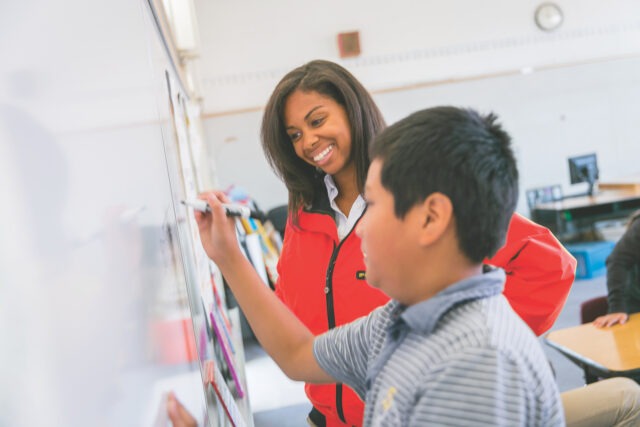Trust is a building block for learning
This blog is based on an AmeriCorps member training guide sponsored by Colgate, which in 2022 awarded City Year the first ever donation from its new Smile Fund, an initiative created to advance the health and well-being of children, their families and communities through support of nonprofit organizations.

Taking the time to create a solid foundation of mutual trust and understanding with students pays off. While the guidelines below are used by City Year AmeriCorps members, they also can help parents better understand what every child needs to be successful in school and how schools can help students recover from pandemic-related disruptions. “A lot of students spent time in isolation,’’ says LaTasha Golden, City Year’s national director of student experience. “We have to help them re-engage in their school community.’’
Elevate student voice and honor identity
Feeling safe, accepted and valued puts students in a better position to learn. Opportunities in school for students to talk about who they are—and will become—increases confidence and strengthens a sense of belonging. Learning about students also comes in handy when trying to motivate them, because it allows you to connect their personal goals to what they’re learning, Golden says.
If you can help a student who wants to run her own company someday understand how numbers are an important part of any business, it can help her push through a difficult math lesson. “The student sees how something that seems irrelevant actually is very relevant to their passions, goals and aspirations,” Golden says. Also, get to know students by asking their names and pronouns—they may have a nickname or a pronunciation they prefer! “You’re giving a student a chance to say, “‘This is who I am, and this is who I want you to know me to be,’” Golden says.

Create belonging
Get students in the right mindset for learning with a routine like regular icebreakers, readiness checks and energizers before starting lessons. Try an ice breaker by asking students to share a ripple (something that inspired them recently); a joy (something or someone that made them happy); an appreciation (something or someone that makes them feel grateful); a window (an insight into how they feel); or a whoopsie (a mistake they made and how they fixed it or overcame it). “Not only are you sharing a part of yourself, but you’re also hearing from others,” Golden says.
Build relationships
Chances to learn about others and feel safe sharing something about yourself, whether it’s your opinion or a life experience, can go a long way toward building connections that can make or break students’ perceptions about school. Storytelling is one way to bring people together. A prompt like “tell me about a time when…” encourages students to tell stories in their own words. Support their efforts to express their own identity, culture and experiences. Listening to students, providing opportunities for them to take on responsibility, and advocating for student needs also builds trust. You can summarize what a student has said to check your understanding, let them perform small tasks independently, and advocate for them—for example, if a student says it’s too noisy to concentrate, you might help them find a quieter place to study.
Support collaborative learning environments
Intentionally creating spaces where students exercise their creativity and critical thinking skills as part of a larger group will help them get to know their peers better, while strengthening both self-awareness and social awareness. “We’re opening up opportunities for trust and openness, and avenues for students to connect what they’re learning in school to their life and worldview,” Golden says. One way to do this is to encourage them to work with different peers so they aren’t always sticking with the same small group—a strategy that helps students learn about and from others. “Getting to know different people and the different ways that others do things, fosters a sense of belonging,” Golden says.
Putting aside time for students to reflect through journaling or group discussion around prompts you create based on a lesson will help them process what they’re learning. Take part in the reflection time with them—it’s another way to strengthen your connection to each other!
Do you know a young adult who wants to become a City Year AmeriCorps member? Share our application with them!
Related stories
We hear time and time again from corps members and alums that when they first joined City Year as an...
Read more about A snapshot of City Year service as a student success coachAs a new City Year AmeriCorps member, you’re about to embark on a transformative journey—and it all begins with Basic...
Read more about Welcome to City Year’s Basic Training Academy: Your First Step Toward ImpactHow do you make your application stand out? Check out these tips from our recruitment staff
Read more about Tips and tricks for a great applicationCity Year Providence AmeriCorps alumnus Justin Roias knows firsthand how positive relationships with caring adults can help children succeed as...
Read more about Mentoring students: a two-way street














